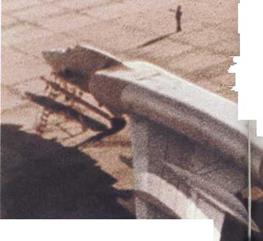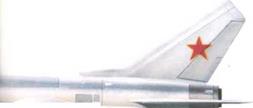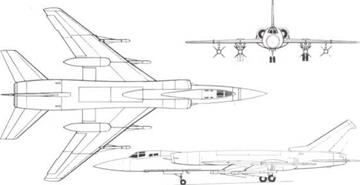Tupolev Tu-28P
Tu-28P "Fiddler";
Tupolev bureau, Tu-102 or Tu-128
Origin: The design bureau of Andrei N. Tupolev, Soviet Union.
Type: Long-range all-weather interceptor.
Engines: Originally, two large axial turbojets of unknown type, each with afterburning rating of about 27,000lb (12,250kg), probably similar to those of Tu-22; later versions, afterburning turbofans of about 30,0001b (13,610 kg) each, as in later Tu-22.
Dimensions: (Estimated) span 65ft (20m): length 85ft (26m): height 23ft (7m).
Weights: (Estimated) empty 55,000lb (25,000kg): maximum loaded 100,0001b (45.000kg).
Performance: (Estimated) maximum speed (with missiles, at height) 1,150mph (1850km/h, Mach 1 75): initial climb, 25,OOOft (7500m)/min: service ceiling (not gross weight) about 60,000ft (18,000m): range-on internal fuel (high Patrol) about 1,800 miles (2900km).
Armament: No guns seen in any version; mix of infra-red homing and radar-homing "Ash” air-to-air guided missiles, originally one of each and since 1965 two of each.
History: First flight, believed 1957; service delivery, probably 1961.
User: Soviet Union (PVO).
 |
Development: Largest fighter known to be in service in the world, this formidable machine is essentially conventional yet has the greatest internal fuel capacity of any fighter and the biggest interception radar known to exist. It was one of a number of supersonic types produced by the Tupolev bureau with technology explored with the family of aircraft of the late 1950s known to NATO as "Backfin" (another is the Tu-22), Like the
 Right: A flight-line of what are in many respects the largest interceptors in regular combat service. The Tupolev bureau has played every kind of tune on this classic basic design, relatives of which are seen in the Tu-22 ‘Blinder’ and the swing-wing ‘Backfire’ long-range multi-role aircraft. It has been reported that the IA – PVO has a missilearmed interceptor version of the Tu-22 in service as a replacement for the Tu-28P.
Right: A flight-line of what are in many respects the largest interceptors in regular combat service. The Tupolev bureau has played every kind of tune on this classic basic design, relatives of which are seen in the Tu-22 ‘Blinder’ and the swing-wing ‘Backfire’ long-range multi-role aircraft. It has been reported that the IA – PVO has a missilearmed interceptor version of the Tu-22 in service as a replacement for the Tu-28P.
Three-view of the Tu-28P long-range interceptor, with four "Ash" air-to-air missiles.
others the Tu-28P has a distinctive wing with sharply kinked trailing edge, the outer 45° panels being outboard of large fairings extending behind the trailing edge accommodating the four-wheel bogie landing gears. Two crew sit in tandem under upward-hinged canopies, and all armament is carried on wing pylons. Early versions had twin ventral fins and usually large belly fairings, but these features are absent from aircraft in current service. The Tu-28P would be an ideal strategic patrol fighter to operate in conjunction with the ”Moss" AWACS.

 |
Left: A typical Tu-28P of the IA-PVO, with МАТО code-name of ‘Fiddler’. Usually these very large long-range aircraft carry two IR – homing and two radarhoming versions of the ‘Ash’ air-to-air missile.










